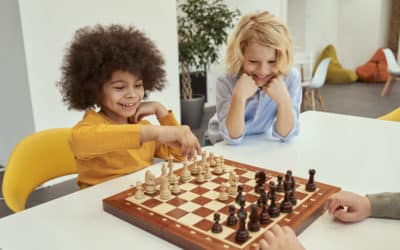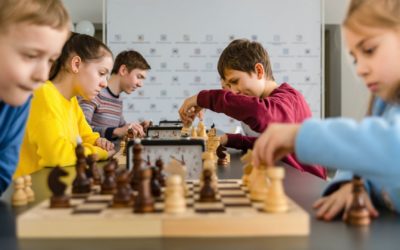Since the beginning of the health crisis, digital technology has allowed teachers and families to stay connected and ensure educational continuity for learners. Nevertheless, the need to streamline digital uses has become a real necessity in order to control screen time and the quality of activities.
The digital uses of home schooling
Digital tools are popular during confinement
School/family communication
If at the beginning of the containment there was a lot of talk about ENT (Environnement Numérique de Travail), the reality shows that few primary school students have taken courses on it. Most of the teachers in the first grade have used email to communicate. Some of them used their class blog or padlets to provide exercises to be done at home. In the end, the students' school screen time did not increase the overall screen time so much. Indeed, the exercises had to be done in writing, in the usual notebooks and files. It was up to the parents to correct or send the work to the teachers.
At first, we were very worried about our 6 1/2 year old son. CP is such an important class! But finally, thanks to his teacher's padlets, we were able to go with Malo. He had mostly reading and writing work in his file. There were also suggestions for make-your-own board games. We are happy that he was able to avoid staying behind a screen!
Margaux and Yohan, Malo's parents
Sometimes the more digitally literate teachers offered online quizzes and/or video conferencing.
Digital exchanges between families
On the other hand, some families regularly connected to the CNED website (My classroom at home). But they are in the minority according to a FCPE for Paris. In addition, this federation of parents noted that families have also exchanged a lot among themselves, via email, but also through What's app. Thus, the mutual aid between parents worked wonderfully to revive the memories of school!
Luckily we had our What's app group of fifth grade parents. It helped us a lot with fractions and division. We laughed a lot too! Our children are far from imagining that we have lost our touch, so talking about it between adults helps to play it down.
Marco, father of Noémie, 10 years old
Assessment of the digital school
Erosion of motivation and school dropout
However, the initial assessment of digital technology in schools remains mixed. Indeed, over time, teachers have noted an erosion of motivation. Depending on the school, more than one out of two students may drop out of school (middle school in an educational complex). In elementary schools, it is not uncommon to find 1/5 to 1/4 of students absent. In these cases, the teachers tried to get in touch by telephone and sometimes associations in the field were able to intervene to prevent the dropout of students in difficulty.
Even for the most motivated students, it is difficult to keep up. The reasons given are pedagogical and psychological.
Difficulty paying attention and lack of interaction
First of all, digital learning is a one-way street, even in a video conference. By not actually being physically involved, a significant amount of attention is lost. How many students turn off the camera and/or microphone to simply be present? In the classroom, the teacher can better gauge the attention of his students and adapt his pedagogy.
On the other hand, the lack of peer interaction penalizes learning. In class, instructions are often explained several times. All the students benefit from their classmates' questions, which improves their understanding of the exercises. Faced with a PDF file or a padlet, the student must understand alone. The help of an adult is essential to ensure that the statements are clearly understood.
I've been juggling second and third grade programs for almost three months now. My kids responded pretty well the first few weeks, but after spring break their motivation dropped. Any written exercise was a chore. We kept arguing. I felt like I was becoming their tormentor. My big boy would botch all his quizzes and the little one would drag out an hour for an unfortunate grammar exercise. No, homeschooling is definitely not school!
Gabriel, father of Lou (8 years old) and Victor (11 years old)
But sometimes children object to parental intervention, which they find either intrusive or devaluing. Within the class group, this problem is less of an issue since the teacher plays his role as instructor. Being a parent and a teacher leads to difficulties in positioning oneself in relation to learning. As long as the child is following, everything is fine, but the machine can quickly break down and the child becomes resistant. From then on, teaching at home takes a conflictual turn. This is probably why parents welcomed the full resumption of classes on June 22.
Recreational digital uses
Telecommuting and children's screen time
Increase in digital uses
If digital uses depend on the social environment, the rate of equipment and the availability of parents, the exposure to screens varies according to the families. In particular with regard to their working methods during and after the confinement.
Out of 32% working full time during the lockdown, 50% were telecommuting. For those who had to combine working from home with childcare, the last few months have been tough! There is a clear correlation between these two factors in terms of children's screen time during this period.
Data for France are not yet available, but the Belgium found an increase in screen time for 60% of under-13s during the lock-in period. Screen time covers all digital uses: TV, tablet, smartphone, digital game console. Depending on the age of the children, the media vary. The youngest children watch cartoons or play simple games on a tablet, while the older ones play mostly online. From now on, parents would like to reduce the use of digital technology.
According to France Soir, "today, 56% parents say that screen time has increased by at least 1 hour per day. 11% of them even estimating the daily increase at more than 3 hours."
How do I deal with my two 5 year old twins when I have to start my zoom meeting at 3pm? They were only allowed 30 minutes of cartoons between 7 and 7:30 pm during the preparation of the meal, but now they have almost 2 hours a day. We try to organize ourselves so that it is not every day, but it is hyper culpabilisant. And moreover we recover them irritated for the rest of the day... I can't wait for the resumption of the school!
Alessandra, mother of Zeno and Mattia
The risk of cabin syndrome
From the beginning of the lockdown, childcare professionals were either alarmed by the overload of screens or tried to reassure about the increase in screen time. They considered that to face this abnormal situation, a relaxation of the family rules was necessary. But today, many parents are worried about the bad habits of their children. How can we restore the taste for playing with friends and going to the park to young people who have played Fortnite more than they should? A survey conducted by the Mobile Lives Forum during the lockdown showed that 18-24 year olds were the category that moved the least during the lockdown (31% never). In contrast, those aged 55 and older used their daily time slot to get out.
Therefore, there is a real risk of prolonged confinement for some young people, mainly adolescents. This age group is concerned by the cabin syndrome. Why leave your home when you are so comfortable in your cocoon? The outside seems threatening, while the inside seems protective. Teenagers need to be accompanied to regain a taste for social life outdoors. Fortunately, the majority of younger children say they are willing to join their friends in the park. Until June 2, the parks were still closed in the red zones. Thus, the outings of the youngest children remained very limited in the urban areas. However, in many places, social life between children resumed before the return to school for all.
As soon as we were able to go out again normally, we took stock of who had access to an outdoor space among us, the class parents. Then we organized ourselves in shifts and small groups so that the games could resume. In our courtyard, there was the day of the CE1, the day of the kindergarten... Like that, we were able to reduce the screen time and work a little more quietly at home. However, if it helps, it's not ideal because we don't always have ideas to entertain them all the time! It's a real relief to be back in school.
Géraldine, mother of Chloé (4 years old) and Marion (7 years old)
The guide to good digital practices
Focus on real social interactions
In fact, child experts advocate a gradual return to a more sensible use of digital tools. The decision to put all children back in school takes into account the importance of real interactions between children for learning.
For several weeks, a group of pediatricians has been claiming that it would be more dangerous for children to stay home than to return to school. The medical data concerning the new coronavirus in young people suggest that they are not particularly at risk. Thus, for the return to school should put the students back in the saddle and also help them to detach themselves from the screens. In fact, the resumption of the school rhythm recreates the previous educational framework and updates the good practices of before confinement.
Psychiatrists' recommendations regarding digital uses
Overall, if you feel a little overwhelmed by your child's screen time, it may be useful to return to the advice of psychiatrist Serge Tisseron. Starting with age 3-6-9-12, he indicates which are the recommended limits. Things to remember :
- before 3 years: no screen;
- 3-6 years old: respect the indicated ages, no screens in the room, neither during meals nor before sleep, participate in games (less than 1 hour/day);
- 6-9 years old: talk about what he/she sees and does, warn about the dangers, no screens in the room;
- 9-12 years old: decide together on screen time and authorized uses, remind them of rules and dangers, talk about what they see and do
- 12 years old and up: respecting schedules, preventing harassment and other dangers of the net, turning off the Wi-fi at night, refusing to be friends on social networks.
Screen time versus outdoor activities
Screen time recommendations are being debated. The CSA recommends 30 to 40 minutes per day for 3-8 year olds and 1 hour for 8 year olds and over. Knowing that the average is currently almost 2 hours, some specialists prefer a weekly average not exceeding 12 hours. This method of calculation makes it possible to include films intended for young people which often exceed 60 minutes.
Furthermore, it is recommended to prioritize quality over quantity: a documentary, a good movie, a game to share with the family, a video call to grandparents or simply, resources and edutainment content (games, activities, educational videos....) accompanying the youngest in their learning and which are sometimes to be used with and/or without screens. To this end, Kidlee has developed Famille Tools, a search engine that lists and facilitates access to this type of content by theme and age group.
With the vacations approaching, digital uses will undoubtedly diminish and return to the place they had before March 16th. A game of snowshoes with a friend, a dive in the pool to splash the parents who are tanning, it's still more fun than an episode of Pyjamasques!


